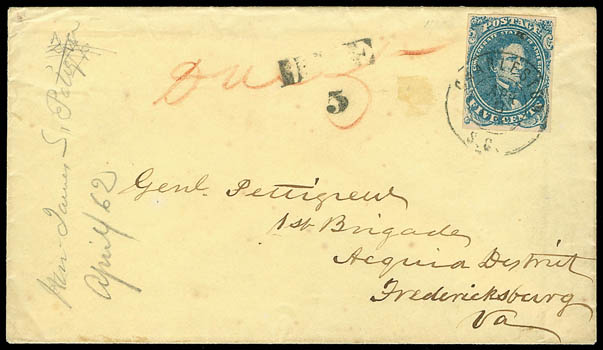
Lot
472 
Confederacy, 1862, 5¢ Blue, Stone 2 (Pos. 8). Large margins to clear at left, tied by "Charleston, S.C./Apr. 8" double-circle datestamp on yellow cover to "Gen. Pettigrew, 1st Brigade, Acquia District at Fredericksburg Va.", "Due 5" handstamp and also in red crayon, "Gen. James J. Pettigrew/April '62" docketing (in his hand?) at left, Very Fine and attractive, with 2004 C.S.A. certificate. Scott No. 4 Estimate $400 - 600.
The addressee, Brig. Genl. James J. Pettigrew, during the Peninsula Campaign (March - July 1862) in the summer of 1862, Pettigrew was severely wounded at the Battle of Seven Pines. He was hit by a mini ball that damaged his throat, windpipe, and shoulder. Pettigrew nearly bled to death, and while lying wounded, he received another bullet wound in the arm and was bayoneted in the right leg. Believing his wounds mortal, Pettigrew didn't permit any of his men to leave the ranks to carry him to the rear. Left for dead on the field, he recovered consciousness as a Union prisoner of war. Exchanged two months later, the general recovered from his wounds, spent the fall commanding a brigade in Maj. Gen. Daniel Harvey Hill's division around Richmond, and the winter commanding a brigade in North Carolina and southern Virginia. He returned to his North Carolina brigade just in time to begin the Gettysburg Campaign in June 1863.
On July 3, Lee selected Pettigrew's division to march at the left of Maj. Gen. George Pickett's in the famous infantry assault now known as Pickett's Charge. This was an error on Lee's part. He did not consult with Pettigrew to find out the terrible condition of the division.
As the division advanced, it received murderous fire. Pettigrew's horse was shot out from under him, and he continued on foot. Reaching within 100 yards of the stone wall on Cemetery Ridge partially held by his cousin John Gibbon, he was severely wounded in the left hand by canister fire. Despite the great pain he was in, Pettigrew remained with his soldiers until it was obvious that the attack had failed. Holding his bloody hand, the despondent officer walked toward Seminary Ridge and encountered General Lee. Pettigrew attempted to speak, but Lee, seeing the horrible wound, spoke first: "General, I am sorry to see you are wounded; go to the rear." With a painful salute, Pettigrew said nothing but continued to the rear.
General Pettigrew continued to command the division during the retreat to the Potomac River until Heth recovered. Stopped by the flooded Potomac River at Falling Waters, West Virginia, Pettigrew's brigade was deployed in a dense skirmish line on the Maryland side protecting the road to the river crossing. Union cavalry probed the southern defenses throughout the night as Lee's army crossed the pontoon bridges into West Virginia. On the morning of July 14, Pettigrew's brigade was one of the last Confederate units still north of the Potomac River, when the Union troopers closed in. On foot and in the front line, Pettigrew was directing his soldiers when he was shot by a Union cavalryman from the Michigan Brigade at close range, the bullet striking him in the abdomen. He was immediately carried to the rear and across the Potomac, having refused to be left in federal hands. He died three days later near Bunker Hill, West Virginia. His brigade, which lost an estimated 56% casualties, had been ruined as an effective combat organization.
Realized: $900
